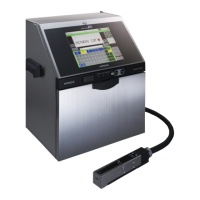(3) Print target detector signal noise filter setting
This function uses to filter the normal noise generated at the print target detector signal and noise generated
by water drops, etc. with CR.
The target sensor filter function (See “Instruction manual 4.14 Set the print specifications”) is effective
against sensor chattering.
Internal circuit diagram
(4) Relationship between print object detection signal and printing operation
*: The printing preparation time minimum
value varies with the print dot matrix, ink
drop use, etc., however, the right table can
be used as a reference.
Nozzle size
Reference of printing preparation
time minimum value
65µm 9 ms
The accurate printing preparation time can be calculated by following formula.
Necessary printing preparation time (Note 1) = [(One scan time) x (N + 1) ] (ms)
(One scan time) =
(Number of vertical dots + Character width) x Ink drop use percentage
Excitation frequency (kHz)
(ms)
N : (One scan time x N) Remaining number that is set to "a"
(a: Refer to the right table.)
Excitation frequency: 75.4 (Model RX, with 65µm nozzle and JP-K69 ink)
>
=
Nozzle size a
65µm 5.5
(Note 1) Time for repeated printing of fixed characters. When using the communications function or
2-dimensional bar code function, it will be longer than the time calculated from this formula.
When the speed is followed up, the number of encoder pulses shown below will serve as reference for the
minimal value of print space:
Excitation frequency (kHz)
(ms)
Minimal time of 1 pulse =
(Number of vertical dots + Character width) x Ink drop use percentage
Number of necessary
a
Minimal time of 1 pulse
Frequency division setting value (pulse)
+
encoder pulses
=

